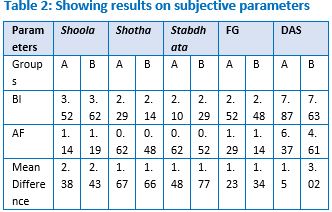A comparative clinical trial to evaluate the efficacy of Rasnadi Churna Basti with Ardha Matrika Basti in the management of Amavata vis-à-vis Rheumatoid Arthritis
DOI:
https://doi.org/10.21760/jaims.7.10.6Keywords:
Amavata, Rheumatoid Arthritis, Rasnadi Churna Basti, Ardha Matrika BastiAbstract
Background: Amavata is one among the pain predominant diseases. The disease Amavata has similarity with Rheumatoid arthritis in clinical presentation. In the present study an attempt was made to compare the efficacy of Rasnadi Churna Basti with Ardha Matrika Basti in the management of Amavata. Objective of the study: To compare the efficacy of Rasnadi Churna Basti with Ardha Matrika Basti in the management of Amavata vis-à-vis Rheumatoid Arthritis. Materials and Methods: A double arm open labeled clinical study with pre-post-test design was carried out at Government Ayurveda Medical College and Hospital, Mysuru. Data was collected as per the proforma prepared for the purpose of the study. Study was completed in 42 subjects with 21 subjects in both the groups. For Group A Rasnadi Churna Basti and for Group B Ardha Matrika Basti in Yoga Basti pattern for 8 consecutive days was administered. The data was analyzed using SPSS descriptive and inferential statistics. Results: The statistical values showed highly significant results in Sandhi Shoola, Sandhi Shotha, Sandhi Stabhdata, functional grading, ESR, and DAS parameters. In CRP parameter, result was statistically significant in Group-A and non significant in Group-B. Hb% parameter showed statistically non-significant results in both the groups. On overall assessment, there was no statistically significant difference in the results between the groups except CRP and DAS parameters. Conclusion: Both Rasnadi Churna Basti and Ardha Matrika Basti are useful in reducing the signs and symptoms of Amavata vis-à-vis Rheumatoid Arthritis.
Downloads
References
Brahmanand Tripati, Editor, 2006, Madhukosha Commentary of Sri Madhavakara on Madhava Nidana, Amavata Nidana adhyaya: chapter 25, verse 1-10. Varanasi: Chaukambha Orientalia, 2006, p575.
Longo D, Fauci AS, Kasper DL, [et al]. Harrison’s Principles of Internal Medicine, 19th edition, vol-II, New York: McGraw-Hill Education, 2015, p2139.
AK Agarwal, P Gupta [et al], Editors. 2015, Munjal YP, API Textbook of Medicine,10th edition, vol-II, chapter 6, by A N Malaviya, The association of Physicians of India, 2015, p2492.
Tripathi JP, 2010, Bhavarthasandipini Hindi Commentary of Cakradatta of Cakrapanidatta, Amavata Chikitsa Adhyaya: chapter 23, verse 1. Varanasi: Chaukhamba Orientalia, 2010, p225.
Acharya YT, Editor, 2014, Ayurvedadipika Commentary of Sri Cakrapanidatta on Charaka Samhita of Agnivesha, Siddisthana; Kalpanasiddi Adhyaya: chapter 1, verse 40. Varanasi: Chaukhamba Orientalia, 2014, p683.
Acharya YT, Editor, 2014, Ayurvedadipika Commentary of Sri Cakrapanidatta on Charaka Samhita of Agnivesha, Siddisthana; Bastisiddi Adhyaya: chapter 10, verse 13-14. Varanasi: Chaukhamba Orientalia, 2014, p725.
Tripathi JP., 2010, Bhavarthasandipini Hindi Commentary of Cakradatta of Cakrapanidatta, Niruhadikara Adhyaya: chapter 73, verse 23-26. Varanasi: Chaukhamba Orientalia, 2010, p602.














